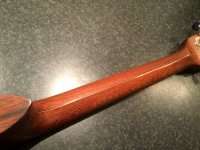Well, Alfred Mirek's accordion tutor book states that you need a minimum 3/4 instrument for it and from memory, most beginner bayan repertoire range exceeds 2 octaves once you've played the instrument for 2-3 months. A 48 bass is a niche instrument that's probably quite detached from its full-sized brother if you ask me, but I'm certainly no expert. And the prices on 48 basses are bloated.
You raise a good point about severe lack of student instruments. And it's not just how and where things are manufactured - it's the design too. I reckon a full-sized box with 3/4 range and two voices in unison in the right + 3 voices in the left will go a very long way if the reeds are really good quality. No registers, no switches, no extra bells & whistles, just a basic but good quality instrument. If these were available for under £1k, they'd sort the problem of student level boxes. But I guess they'd eat into the manufacturers' profits quite a bit.
Hi tcabot I think it is just a different perspective on instruments and how they are used.
What I find most inspiring are the musicians that seem to take their instrument to another level, I'm thinking the likes of Tommy Emmanuel,Jerry Douglas,Hilary Hahn,Glenn gould Roy smeck Davy spillane,Mary Bergin and I added Sandy Brechin
At 3.52 he plays with such gusto
I have no concept of how well you play,you might even go on the list but I'm mid 60s and I think it's going to take quite a while to play anything like as fluent as this ,and one of my reasons for buying the Hohner student VM 48 was, it's what he's playing so the only hurdle to playing something approaching this ,is practice and ability.
The retired professional accordionist that has given me a few lessons and comes pretty close ,plays just about all genres effortlessly ,but I just don't have 50 years left to practise so my thoughts factoring in the time restraints is. learn one style in the traditional keys and hopefully play it quite well ,opposed to trying to play everything poorly.
I have played a 120 bass and it's really not for me I like being able to “not exactly throw it around” but play with a bounce and it feels more comfortable a bit like my melodeons and my god it was so heavy it must have been three time the weight of the Hohner student.
I have never heard of Alfred Mirek's and if as you say his accordion tutor may states that you need a minimum 3/4 instrument
In my school books, Pluto was a planet Pluto is now technically a “dwarf planet,”
So I wouldn't believe everything you read in books



